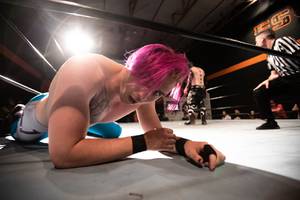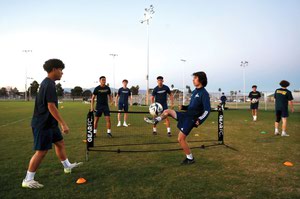A father walks into a Henderson sporting goods store and makes a desperate plea: Another season of youth baseball is beginning and he’s so short on cash he can’t afford gear for his son.
The man is recovering from leg surgery and out of work. He expresses the outlandish cost of equipment—one of those modern bats many of the kids are swinging costs up to $500, after all—and fears he’d be labeled a bad parent if he doesn’t outfit his son with the best.
The store’s business model allows customers to exchange used equipment for store credit or cash, paving the way for the man to sell two bats and a glove. With the credit, he was able to get the new gear for only $3.
“I felt so bad for the guy,” says Scott Pisan, owner of Play It Again Sports on Valle Verde Drive. “He said, ‘I’m so strapped for cash. If you weren’t able to do this, my son wouldn’t be able to play.’”
Pay to play
The man’s dilemma is not uncommon, parents told Weekly, as local families are shelling out tens of thousands of dollars annually for their children to chase athletic success.
Parents and their children might have many goals from athletics: some want simply to participate, some dream of college scholarships, others hope to make it in professional sports. But this much is certain: In Las Vegas and across the country, satisfying those dreams—some might say exploiting them—has become very big business, and parents are finding themselves shelling out fortunes to support their kids in sports.
From the minute a child enrolls in a sport it can feel like the meter is running at $100 a minute. Take youth soccer, where one Las Vegas family said it pays $995 annually to participate with a local club, $75 in monthly coaching fees, $400 for uniforms, another $125 for cleats and a $100 entry fee per tournament. They’ve played in six tournaments alone this year, including those hosted out of state.
The travel to those events could be $1,000 or more, depending on if it is by car or air. And these parents, like many across the city, are doing it all for both of their children.
The club also offers private training, the family said, which costs $120 an hour—but that’s where they drew the line, because they’re already spending $10,000 a year for each child to compete.
It’s not only soccer. We spoke with families who have children enrolled in youth baseball, football, gymnastics and volleyball who detailed similar costs. We found thousands of Las Vegas families are spending more than $1,000 a month, if not more.
It’s an arms race to outfit children and give them the training to compete. One parent described the constant costs as “like having an extra car payment.” Another said they have a credit card specifically for youth sports—and admits that card often carries a balance.
It could be considered money poorly spent when just 2% of 460,000 NCAA athletes in 2022-23 advanced to the professional ranks, according to the NCAA.
The chances for a college scholarship are also slim, the NCAA reports, with just 3.5% of high school seniors in 2022 making a men’s college basketball team. It’s 5.6% of prep seniors in men’s soccer, 7.3% for football and 7.5% for baseball. For girls, 7.2% of high school seniors advance to college soccer, 5.6% in softball, and 4.1% in basketball.
You don’t need to pay this kind of money to reach the college or professional ranks, says Tyrell Crosby, a Green Valley High School product who played four seasons with the Detroit Lions through 2022. The only personalized coaches Crosby had were from the high school or youth programs he was part of.
Crosby doesn’t mince his words when talking about personal trainers offering to develop athletes eyeing a spot at the next level: “99% a scam,” he says.
One of the convenient stories we tell ourselves is that youth sports is about building character, learning teamwork, being active and staying fit. Unfortunately, too often it has become a high dollar, high pressure form of abuse for kids and their parents that’s increasingly riddled with issues of class, worries about household finance and fears of letting our kids down. The space is filled with individuals happy to part parents from their hard-earned dollars and continue the false promise of sports stardom for their children.
An entire industry has sprung up around sports fantasies. Families keep pouring money into the activity wrongly believing their investment will lead to scholarships and stardom, but in reality, the expense is bringing families to a financial brink and becoming a great class separator because working-class families aren’t keeping up.
Roger Tabor, the president for Downtown Las Vegas Soccer Club, says the economic divide is most obvious in girls soccer. “It’s hard to attract girls to our teams,” he says of his Downtown-based program, “because it’s become a suburban, white-bread sport.”
Even worse: The stress from playing youth sports is leading to mental health problems for teens, whose personal value has become measured on what they accomplish in sport, or if they can receive praise from a coach. Add to that the pressure of knowing your parents are paying a fortune to support you. Combined, it’s a formula for a crisis in a child that can manifest in problematic moods, anxiety, eating disorders and substance abuse.
The high costs of youth sports come with plenty of benefits, says Ryan Day, who has coached in various Las Vegas youth clubs over the years and raves about their benefits for children.
Take his oldest daughter, who is in law school at Arizona State and has excelled academically because of the time management skills she developed balancing a hectic schedule of soccer tournaments and practices, her father says.
“She learned to deal with adversity, learned to set goals and accomplish them,” Day said. “Training in soccer directly helped with her studies. She had to come home straight from school and get homework done immediately. It’s a regimented cycle and kids get used to that at an early age.”
Day is glad his son is following a similar path. The younger Day is only seven years old but has already traveled out of town for a handful of tournaments and is making meaningful friendships. The child is constantly nagging his parents to go train, and the family has no reservations about making the investment. They spent $2,000 to travel to a tournament recently in Utah.
“Most of the juniors’ programs in town do a good job of delivering on providing enjoyment to the kids and making it fun,” Day says.
He says he is more than sympathetic to the club dues and coach fees, because most coaches have advanced coaching licenses and spend countless hours away from their family. It’s a stipend for most coaches, he says, and many still have full-time jobs. He’s a volunteer coach in a club.
A spokesperson for the Nevada Attorney General said there had been no complaints filed by families claiming they were unfairly taken advantage of by a youth club or personalized coach.
The Aspen Institute found that American families are spending up to $40 billion annually on youth sports, and it’s easy to see how. Take the Candelaria family of Henderson, who this summer will be dropping $10,000 for their family of four to travel to Cooperstown, New York, for a baseball tournament, father Reese Candelaria says.
It’s a trip of a lifetime for his 12-year-old son, who will spend the week sleeping in dorms at the National Baseball Hall of Fame and Museum and competing against teams from across the country.
“Financially, we are in a spot where we can do this for our kids and you only get to live life once,” Candelaria says. “It’s also the lessons of being on a team and how to work in a system. It teaches communication. If you don’t get the outcome you want, go talk to your coach.”
The family pays $50-$75 in tournament entry fees for about 12 events a year. They also have to cover traveling fees when playing out-of-state. Additionally, the club charges $150 monthly in team dues, which is used for park rental and coaching stipends.
“It costs a small fortune,” Candelaria says. That includes the cost of equipment, which “is just insane,” he says.
The Easton bat his son will be using costs $500 retail, but the family preordered it for $400 for a small savings. Those savings went directly to a personalized batting coach who charges $50 a lesson.
Candelaria is direct when describing the state of pay-to-play club baseball: It’s ruining the sport. The rising costs are “making it so that only those fortunate enough to be able to afford the training will play in high school.”
Those athletes whose families can’t keep up financially aren’t getting the practice reps needed to develop, often being replaced on rosters by inferior athletes simply because their parents can pay, he says.
“It’s created an uneven playing field,” he says. “In essence, club baseball is ruining baseball.”
Youth sports don’t have to work this way. There are multiple recreation leagues across the city offering eight-week sessions for as little as $110, including uniforms, field rental and referees. Those leagues, like recreation-based National Youth Sports Nevada, also offer minimum play standards so that all children can experience the beauty of competition.
Tabor started Downtown Las Vegas Soccer Club to service athletes primarily living in the Downtown area with an eye on closing the gap between families with extra resources for their children to compete and those families that needed help. They have eight teams competing at the game’s top youth level—and most of the players aren’t strapped with large monthly expenses.
The club does charge fees for recreation players in seasonal leagues.
“Our sole purpose is to raise money for the kids. That is why we exist,” Tabor said. “The cost of field rentals, coaching, insurance ...we pay for a lot of that stuff.”
The club receives funding from hosting the Las Vegas Mayor’s Cup, which last month brought 935 teams—including 67 from out of the country—for one of the premier youth events annually in America.
If there’s not enough funds for traveling, families do have to chip in to cover the cost, Tabor says, but that’s minimal.
“That was my motivation in starting this thing,” Tabor says. “I thought I could change the world in three to five years.”
Many clubs across multiple sports in Las Vegas have scholarship opportunities, especially when it comes to club basketball for high-school aged athletes who are exceptional prospects already with college scholarship offers. The Las Vegas Knicks (Puma) and Vegas Elite (Nike) are sponsored by shoe companies who arrange for apparel, training costs and tournaments.
Taylor Bigby was so sought-after on the club circuit that a team from Southern California paid for her travel to compete with them, her father, Lamar Bigby, says. Taylor was a McDonald’s All-American at Centennial High School and now plays for nationally ranked USC.
The elder Bigby, director of Tarkanian Basketball Academy on Sahara Avenue, sees countless families taking their children for high-priced lessons and practices with trainers who rent court space. And there’s nothing wrong with that, because “they are about that life and chasing the dream,” says Bigby, who is also the director of the Las Vegas Knicks. Some athletes pay a season fee of $1,200, which covers travel to multiple events, and practice court and coach fees.
There’s a misconception that young athletes need to focus only on one sport or have their families excessively invest in specialized training to succeed—whether that’s winning a game or match, catching the eye of college coaches, or eventually becoming a professional.
Crosby also played basketball and competed in track during high school, saying he kept signing up for activities because he wanted the full prep experience. And the only personal training he received came from coaches at the school.
He was a blue chip prep recruit who started immediately at the University of Oregon and was part of the Ducks’ Rose Bowl championship team in 2014.
“I had confidence in myself. We weren’t going to pay to go to the next level,” Crosby says. “For me, camps were kind of pointless because you can only do so much without pads on. You have to prove yourself during the season.”
Crosby isn’t the only Las Vegas player who thrived without pouring money into developing.
Will Hernandez, an offensive tackle for the Arizona Cardinals, didn’t play football until he arrived at Chaparral High School. The only specialized training he received was from prep coach Bill Froman, who had a background in weight training and transformed the oversized teenager into a powerful force on the line.
Hernandez was lightly recruited out of high school and had just one scholarship offer: The University of Texas, El Paso was willing to take on a project. He got up to speed, redshirting his initial season at UTEP and starting 49 straight games to close his college career. He was selected 34th overall in the 2018 draft and has made $14 million in six NFL seasons.
“If a child is talented enough, they will be recognized with how they play and find a (scholarship) to college,” he says.
More important, Crosby stresses there needs to be balance in a young person’s life or they run the risk of burning out. After all, there is plenty of pressure—including financial—that can lead to kids loathing sports they once loved and leaving families wondering if we haven’t drifted too far from what makes youth sports great in the first place.
Crosby, when speaking with teenagers, proudly details his different approach. “I figured out a good balance. I could never 100% eat, think, and sleep football because that’s not fun,” he says. “I took fun out of every experience and that balance helped me enjoy football more. I wanted to play Xbox with my friends or play other sports. It’s not a job; you don’t have to take it so seriously.”
Buyer Beware: 5 things to watch out for when getting a trainer for your young athlete
Fee increases
The trainer asks for more money but provides the same service.
Service decreases
The training sessions are shortened, or the trainer spends the entire hour occupied on their phone and not focusing on your athlete’s development.
Overcrowded sessions
Trainers usually have sessions with multiple athletes, but there needs to be a cap in the number of pupils they are working with. Too many athletes mean less reps for your child. You can also ask for individual sessions, where the rate could be doubled for the trainer to work exclusively with your child.
Venue choice
If the session is being conducted at a public park where the lights are off, it’s likely not conducive to enhancing your skill set. Trainers book field or court space with parks recreation departments. They also reserve a court at a gym or spot at a batting cage facility.
No improvement
If you’ve been to multiple sessions with a trainer but your athlete is still struggling in competition, it’s time to cut bait. Try a different trainer—or sport. Just because a trainer’s methods work for one athlete, the methods might not fit for others.
The Price to Play
We asked Las Vegas families to detail how much they paid for their young athletes to compete. Here’s a sampling:
THE GEAR
Wilson GST Prime Football: $164.95 (The family also spent $40 to send it to a company to break in the ball.)
Demarini BBCOR baseball bat: $449.95
PING Junior golf club set: $575
THE TEAM
Vegas Elite basketball: $135 monthly (Practices are 75 minutes, twice weekly).
Desert Gymcats gymnastics: $369 monthly (Practices are one hour, twice weekly).
NSA Stars baseball: $150 monthly team dues; $50-$75 tournament dues (About 12 tournaments annually).
Heat FC soccer: $995 annual registration; $75 monthly coaching fee; tournament fees of $80-$100 per player (six tournaments from February-April); $400 every two years for uniforms.
THE TRAINER
Batting cage: $30 for 30 minutes (you provide the pitcher); $50 for 30 minutes with coach.
Agility and strength drills: $55 per hour at Phase 1 Sports.
Baseball lessons: $160 for four 30-minute sessions at Las Vegas Baseball Academy.
Specialized coach training: Soccer, $120/hour (can be split up to five players); Football quarterback, $100 per hour for group session.
Click HERE to subscribe for free to the Weekly Fix, the digital edition of Las Vegas Weekly! Stay up to date with the latest on Las Vegas concerts, shows, restaurants, bars and more, sent directly to your inbox!






